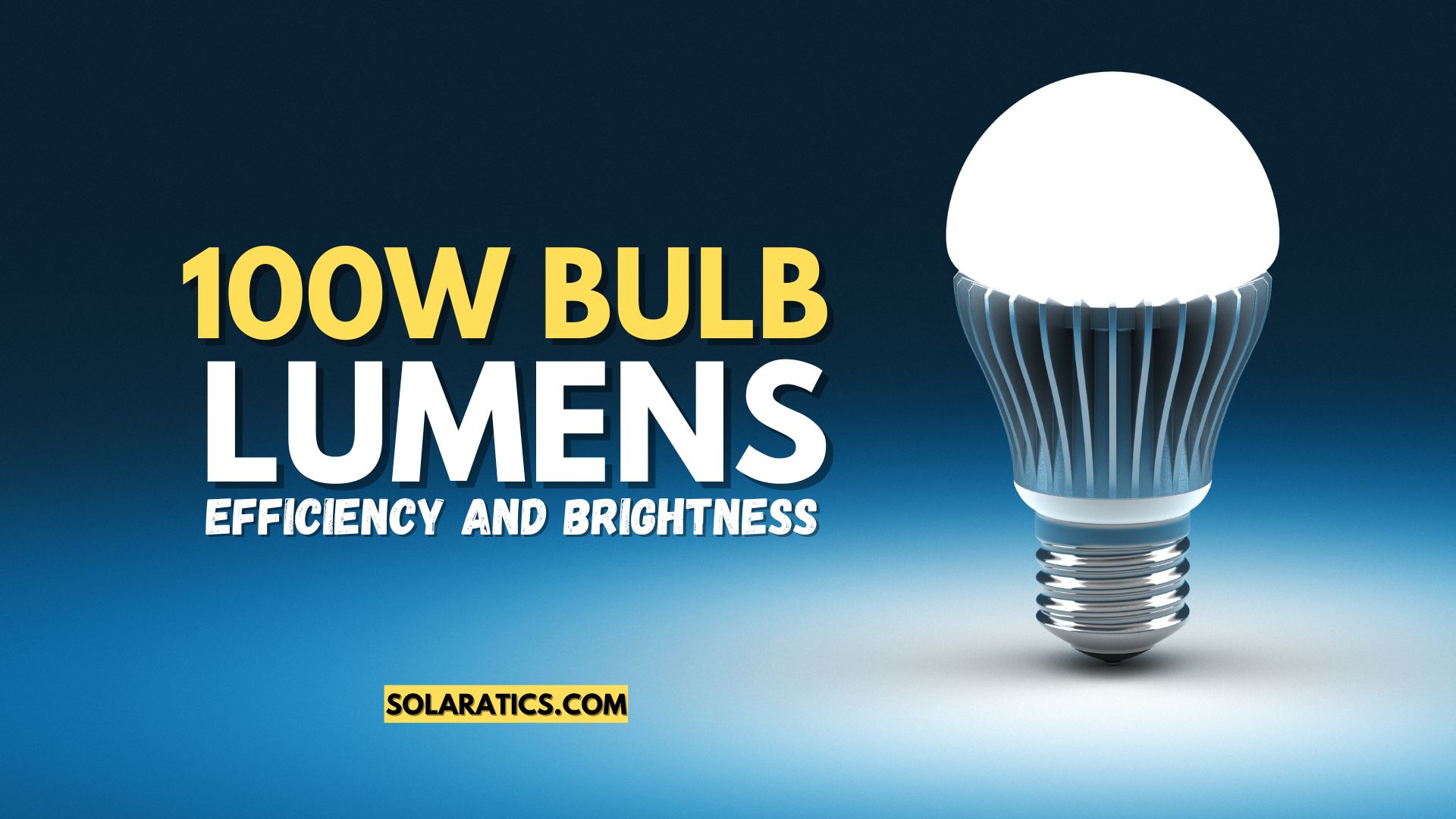100W Bulb Lumens: Efficiency and Brightness

Ever wondered what the difference is between a 60-watt bulb and a 100-watt bulb? Traditionally, wattage was the go-to measurement for light bulb brightness. But times have changed, and a new term has emerged: lumens.
Lumens are a more accurate way to gauge a bulb’s brightness, and understanding lumens is key to choosing the right bulb for your needs.
Introduction to Lumens and Wattage
Let’s break down the two main players: lumens and watts.
- Lumens: Imagine lumens as a measure of the total amount of visible light a bulb emits. The higher the lumens, the brighter the bulb. Think of it like water flowing from a faucet; more lumens means a stronger stream of light.
- Watts: on the other hand, Watts measure the energy a bulb uses. It’s like the size of the pipe supplying water to the faucet. A higher-wattage bulb uses more energy, even if it doesn’t necessarily produce more light.
Relationship Between Watts and Lumens
In the past, a 100-watt incandescent bulb was a standard for bright light. However, these bulbs were also energy guzzlers. Today, thanks to technological advancements, we have LED bulbs that can produce the same amount of light (lumens) using significantly less energy (watts).
Here’s a quick analogy: Imagine two buckets filled with water. One bucket (incandescent) is wide open, letting a lot of water (energy) flow in quickly, but it might not fill all the way (lumens). The other bucket (LED) has a smaller opening, letting in less water (energy) at a slower pace, but it fills up just as much (lumens) because there’s less waste.
Importance of Lumens in Lighting

So, why are lumens important? Here are two key reasons:
- Energy Efficiency: By focusing on lumens instead of watts, you can choose bulbs that provide the brightness you need while using less energy. This translates to lower electricity bills and a smaller environmental footprint.
- Brightness Levels: Lumens allow for a more accurate comparison of brightness between different bulb types, regardless of wattage. You can easily find an LED bulb that delivers the same level of illumination as a traditional incandescent bulb but with significant energy savings.
The 100-Watt Bulb: A Historical Perspective
The 100-watt incandescent bulb was once a household staple. These bulbs were relatively inexpensive and provided a familiar warm light. However, their inefficiency became a growing concern. A significant portion of the energy they consumed was wasted as heat, not light.
Transition to Energy-Efficient Lighting
To address these concerns, regulations were introduced to phase out incandescent bulbs and promote more energy-efficient alternatives. This led to the rise of LED (light-emitting diode) bulbs.
Phasing Out of Incandescent Bulbs
Many countries, including the United States, have implemented regulations phasing out the sale of traditional incandescent bulbs. This is because LED bulbs offer significant advantages:
- Energy Savings: LED bulbs use up to 80% less energy than incandescent bulbs to produce the same amount of light.
- Longer Lifespan: LED bulbs can last 25 times longer than incandescent bulbs, reducing the need for frequent replacements.
- Environmental Impact: By using less energy, LED bulbs contribute to a smaller carbon footprint.
Adoption of LED Bulbs
With their numerous benefits, LED bulbs have become the preferred choice for lighting. They are available in a wide range of styles, colors, and lumen outputs, making them suitable for any application.
Lumens Output of a 100 Watt Incandescent Bulb
A traditional 100-watt incandescent bulb typically produces around 1600 lumens of light. This is a good benchmark to keep in mind when choosing an LED replacement.
Comparison with Modern LED Bulbs
Modern LED bulbs can achieve the same 1600 lumens of brightness using a fraction of the energy compared to a 100-watt incandescent bulb. For example, a high-efficiency 12-watt LED bulb can deliver the same level of light as a traditional 100-watt bulb.
How Many Lumens Does a 100-Watt Bulb Produce?
As mentioned earlier, a 100-watt incandescent bulb typically produces around 1600 lumens. However, it’s important to remember that this is a general guideline. The actual lumen output of a bulb can vary depending on several factors.
Choosing the Right Bulb for Your Needs

Now that you understand lumens and their importance, how do you choose the right bulb for your needs? Here are some things to consider:
- Room Size and Purpose: Larger rooms or areas requiring intense task lighting will need bulbs with higher lumen outputs (around 2500 lumens or more). For smaller spaces or ambient lighting, lower-lumen bulbs (around 800 lumens) might suffice.
- Light Color Temperature: Light color temperature is measured in Kelvins (K) and refers to the “color” of the light. Warmer light (around 2700K) is ideal for creating a cozy atmosphere, while cooler light (around 5000K) is better suited for task lighting.
- Beam Angle: The beam angle determines how concentrated the light is. A narrow beam angle (spotlights) is good for highlighting specific areas, while a wider beam angle (floodlights) is better for general illumination.
Lumens vs. Watts: Making the Comparison
Here’s a table summarizing the key differences between lumens and watts:
| Feature | Lumens | Watts |
|---|---|---|
| Measure | Amount of visible light | Energy consumption |
| Importance | Determines brightness | Determines energy use |
| Focus for Choosing Bulbs | Focus on Choosing Bulbs | Consider lumens and watts for energy efficiency |
Benefits of Using LED Bulbs Over Traditional Incandescent Bulbs
We’ve touched on some advantages of LEDs, but let’s delve deeper:
- Energy Savings: As mentioned earlier, LED bulbs are significantly more energy-efficient than incandescent bulbs. This translates to lower electricity bills and a positive impact on the environment.
- Longer Lifespan: LED bulbs can last up to 25 times longer than incandescent bulbs, reducing the need for frequent replacements and saving you money in the long run.
- Environmental Impact: By using less energy, LED bulbs contribute to a smaller carbon footprint. This helps combat climate change and promote a more sustainable future.
- Heat Generation: Incandescent bulbs generate a significant amount of heat, which can contribute to discomfort, especially in warmer climates. LED bulbs emit very little heat, making them a cooler and more comfortable lighting option.
- Dimming Capabilities: Many modern LED bulbs offer dimming capabilities, allowing you to adjust the light level to suit your needs and create different moods in a room.
Also Read: 5 Best Solar Christmas Lights for Eco-Friendly Holiday Decor
Conclusion
Lumens are the new standard for understanding light bulb brightness. By focusing on lumens, you can choose energy-efficient bulbs that provide the perfect level of illumination for your needs.
With their numerous advantages, LED bulbs are the clear choice for sustainable and cost-effective lighting. So next time you’re replacing a bulb, consider the power of lumens and make the switch to LEDs!
